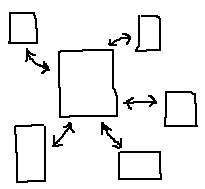
Problem: How should the artifact's working surfaces be organized?
Forces:

If you are revising the design of an artifact, find out if users spend a lot of their time going back and forth between two or three different surfaces instead of just one. If that's the case, consider consolidating these most-frequently-used areas into one working surface, or into Tiled Working Surfaces, or at least into a Stack of Working Surfaces; the idea is to minimize the amount of unnecessary back-and-forth the user has to do. (But don't do this if it ends up inhibiting their work, obviously.)
Resulting Context: The Central Working Surface could be the first thing the user sees upon starting to use the artifact, but not necessarily -- this may be better done by some other working surface, whose express purpose is to orient the new user and direct them towards one subpart or the other. This would be especially true with an artifact which supports multiple activities, which may even require multiple Central Working Surfaces to properly support those activities (and may thus give the impression of being two or more separate artifacts). Consider a multimedia reference book, in which one may either browse casually or do a directed search for certain information. Such an artifact may have two different "home bases" where work gets done -- one for browsing, one for searching.
Notes: This pattern is more analogous to an architectural space than most others in this language. It's meant to be like a workshop, an office, or a living room, and not so much a lobby or reception room -- you do stuff there, it's within easy reach of other places you want to go, etc.
The pattern relates to the concept of a "strong center" as formulated by Christopher Alexander in his upcoming work, The Nature of Order. The idea is that a strong center, surrounded and supported by a set of smaller centers (e.g. the secondary working surfaces), is a fundamental organizing principle that the human mind can easily grasp. Central Working Surface evokes this principle both in terms of transition states and visual representation.
Copyright (c) 1999 by Jenifer Tidwell. All rights reserved.